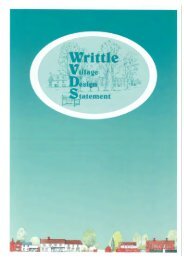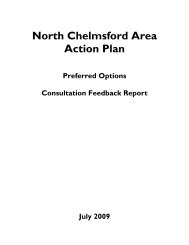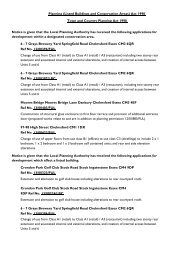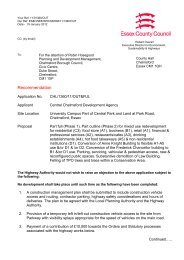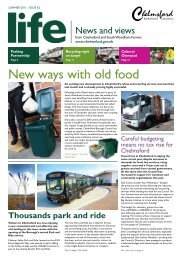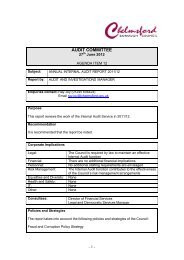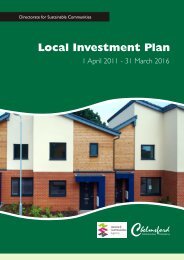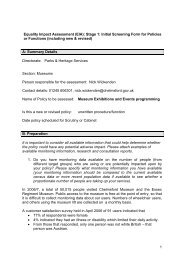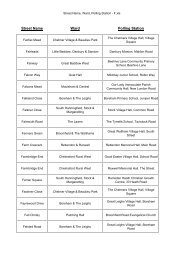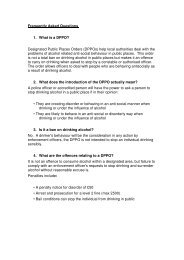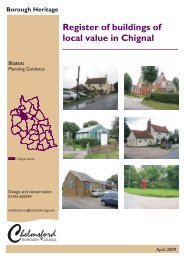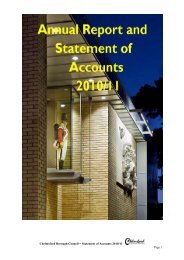Landscape Character Assessment - Chelmsford Borough Council
Landscape Character Assessment - Chelmsford Borough Council
Landscape Character Assessment - Chelmsford Borough Council
You also want an ePaper? Increase the reach of your titles
YUMPU automatically turns print PDFs into web optimized ePapers that Google loves.
153and Good Easter in the lower lying areas surrounding the River Can and its tributaries. On the higherland in the middle and to the east there are fewer trees or woodland pockets providing more open viewsacross the patchwork of fields. In addition to the arable farmland there are clusters of smaller fieldsand paddocks with improved grassland and bounded by wooden or white tape fencing. These aregenerally located around the hamlets or farmsteads and are used to graze horses. Other medium sizedpastoral fields are located in the lower regions of the area around Mashbury and Good Easter in thefloodplains of the watercourses. Throughout the area are scattered ponds, lakes and reservoirs. Thereis a concentration of these to the south east of the area. Some of these water bodies are the result offilling disused sand and gravel pits with water. Local vernacular buildings are found dispersed acrossthe area concentrating in the hamlets and small villages that are scattered throughout the area. Thesebuildings are generally colour washed with tiled or thatched roofs. There are several large halls in thearea including Mashbury Hall and Pleshey Grange. Trees generally screen settlements and isolateddwellings from the surrounding open farmland. There is an overall sense of tranquillity throughout thecharacter area with several quiet, rural lanes winding through the landscape.Visual <strong>Character</strong>istics. The key landmarks within the Pleshey Farmland are the water tower northwest of Greenstreet andthe spires or towers of the churches at Pleshey, High Easter and Good Easter from the surroundingfarmland. The views within the area vary from open views over the arable farmland on the highest land to theenclosed views in the valleys in the south of the area.Historic Land UseEvidence of historic land use within the <strong>Character</strong> Area is dominated by small irregular fields ofancient origin across the area, with pockets of sinuous co-axial fields. Historic dispersed settlementpattern, often originally focussed on greens, with scattered farmsteads survives. The main historiclandscape features include: Small roads and green lanes linking settlements, many of which have survived. A few, small woods of ancient origin surviving.Ecological FeaturesThis <strong>Character</strong> Area is dominated by intensive and widespread arable agriculture. The area contains 16sites of nature conservation value. These include Seven CWSs with ancient and semi-natural woodland habitats including Margaret Roding Wood,Garnetts Wood, Crows Wood. Four small areas of ancient and semi-natural woodland further south. Nine CWSs with unimproved grassland, scrub and wetland habitats including Leaden RodingMarsh/Longstead Lane, Barnston/High Easter - Onslow Green, part of Hounslow Green and sixCWS sites further south.Key Planning and Land Management Issues Potential for pollution of the ditches and streams that cross the arable farmland from fertilizer andpesticide run-off from the fields. Potential for erection of new farm buildings on the higher areas, which could be conspicuous on theskyline. Potential further decline in condition of field boundaries through further agricultural intensification. Increase noise disturbance in the northern part of the area from airplanes taking off and landing atStansted Airport if the airport expands.11100101R Final LCAs_09-06Section 5.0 – <strong>Landscape</strong> <strong>Character</strong> of <strong>Chelmsford</strong> <strong>Borough</strong>



